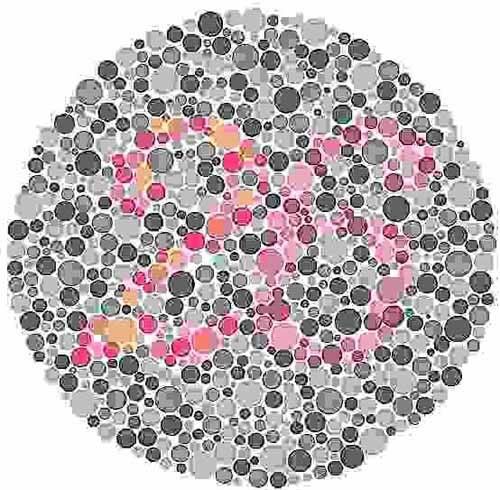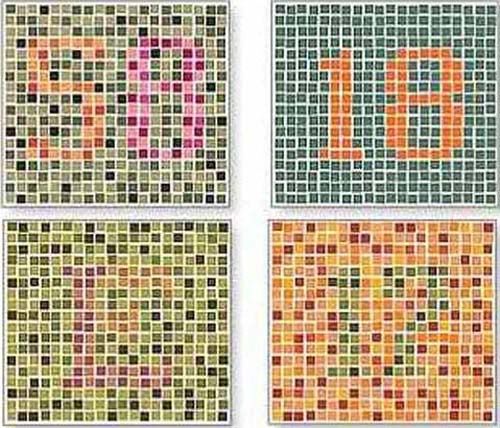 Sometimes, optical illusions can serve a purpose. These images might seem familiar to you; look closely. Do they remind you of anything? If you have a driving license, or attended a medical exam at some point in your life, there is a big chance you encountered these during the process. Attached on your left, and below you may find some examples of color blindness test used for testing if person is partially of fully color blind.
Sometimes, optical illusions can serve a purpose. These images might seem familiar to you; look closely. Do they remind you of anything? If you have a driving license, or attended a medical exam at some point in your life, there is a big chance you encountered these during the process. Attached on your left, and below you may find some examples of color blindness test used for testing if person is partially of fully color blind.If the numbers don't jump out at you immediately, if you have hard time distinguishing the colors apart, or if you aren't able to easily distinguish at least a vague guess as to what the number is, then you my friend are unfortunately - color blind.
 A version of this test can be seen used in the film Little Miss Sunshine, in which a small girl is playing with the vision test chart with her brother. He is not able to see the numbers, or tell the different colors apart well enough to distinguish the numbers. The boy's goal was to be a pilot, so when he is made aware that he's colorblind, the poor kid has a small nervous breakdown. As we already stated, color blindness, or color vision deficiency, is the inability to perceive differences between some of the colors that others can distinguish. It is most often of genetic nature, but may also occur because of the eye, nerve, or brain damage, or due to exposure to certain chemicals.
A version of this test can be seen used in the film Little Miss Sunshine, in which a small girl is playing with the vision test chart with her brother. He is not able to see the numbers, or tell the different colors apart well enough to distinguish the numbers. The boy's goal was to be a pilot, so when he is made aware that he's colorblind, the poor kid has a small nervous breakdown. As we already stated, color blindness, or color vision deficiency, is the inability to perceive differences between some of the colors that others can distinguish. It is most often of genetic nature, but may also occur because of the eye, nerve, or brain damage, or due to exposure to certain chemicals. Before we proceed onto our next example, here is a little history lesson: The English chemist John Dalton published the first scientific paper on the subject in 1798, "Extraordinary facts relating to the vision of colors" after the realization of his own color blindness. Because of Dalton's work, the condition is sometimes called daltonism, although this term is now used for a specific type of color blindness, called deuteranopia. Below you may see the example how one that is colorblind can't distinguish the numbers on the card. Don't be mistaken, color blind people don't see everything in black and white, I just gave this as a guideline so you can understand their inability.


Color blindness is not the swapping of colors in the observer's eyes. Grass is never red, and stop signs are never green. The color impaired do not learn to call red "green" and vice versa. However, dichromats often confuse red and green items. For example, they may find it difficult to distinguish a Braeburn from a Granny Smith and in some cases, the red and green of a traffic light without other clues (e.g., shape or location). This is demonstrated in this simulation of the two types of apple as viewed by a trichromat or by a dichromat.

In certain situations, color blindness is classed as a disability. However, color blind people have some advantages over people with normal color vision as well! There are some studies which conclude that color blind individuals are better at penetrating certain camouflages.

On your left, you may see another color vision test card. This one is pretty hard, as some individuals with perfect vision may have problems seeing the number inside it - it is 56 if I'm not mistaken.
Hope we learned something useful today. Before I conclude this article, there are some more vision test examples for you to enjoy:

And then some more... Examples below are much bigger in size. If you had no problem recognizing previous numbers, but have more problem distinguishing these, don't be afraid - it has nothing to do with color blindness. Probably its just that your eyes can't capture the whole image at once.


written by Vurdlak, with additional help from Vernon Southward of Macro Photography. If you would like to have your article appear on Mighty Optical Illusions as well, feel free to contact us.


No comments:
Post a Comment